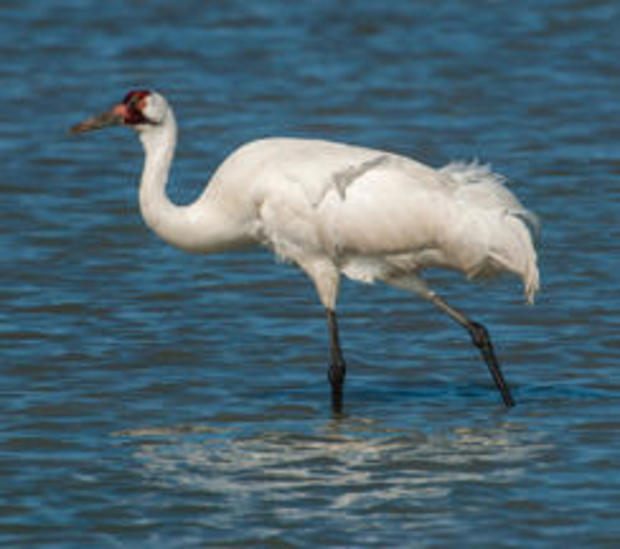Nature up close: Whooping cranes
By "Sunday Morning" contributing videographer Judy Lehmberg.
In the summer of 1998 we spotted two whooping cranes while driving along the Slough Creek Road in Yellowstone National Park. Wait -- whooping cranes don't live in Yellowstone! They spend their nesting season in Wood Buffalo National Park in northern Canada in the summer, and Aransas National Wildlife Refuge near Rockport, Texas, in the winter. Seeing bird watchers scratch their heads as they combed through their bird guides was pretty entertaining the rest of that summer.
We later learned Operation Migration was trying to establish a new population of whooping cranes by training them to following an ultralight aircraft. Some of those migration experiments worked, although the Yellowstone introduction was not successful.
To understand why a new population was so important it is essential to understand the history of whooping cranes. In 1979, when "CBS Sunday Morning" first aired, whooping cranes had been on the Endangered Species List for six years. They had been endangered much longer, but the act only came into existence in 1973 when President Richard Nixon signed it into law.
It is estimated there were somewhere between 10,000 and 20,000 whooping cranes before Europeans settled in North America. By 1870 that number had declined to about 1,300 birds, and by 1937 the population had crashed to only 15. There were several reasons for their decline: Hunting was one, but the major blow came from habitat loss. Much of the Midwestern prairie potholes in Illinois, Iowa, Minnesota and North Dakota, essential for crane nesting, have been plowed to produce corn and wheat. In 1937 President Franklin D. Roosevelt established Aransas National Wildlife Refuge on the Texas coast to protect the only wintering habitat for whooping cranes.
Their wintering grounds were protected, but no one knew where they nested; whooping cranes are migratory. Historically, they spent their winters along the Gulf Coast of Louisiana and Texas, and the spring and summer nesting in the U.S. Midwest and Canada. Biologists knew they no longer nested in the U.S., so they looked for them in Canada. They spent years searching with no results. Finally, in 1954 their only remaining nesting site was found, at Wood Buffalo National Park in southern Saskatchewan and northern Alberta, Canada. That find proved essential to whooping crane recovery efforts.
One of the prime reasons whooping cranes are susceptible to extinction is their low reproduction rate. It takes four to seven years for a baby whooping crane to become sexually mature, and a nesting pair normally raises only one chick a year, if they are lucky. The female almost always lays two eggs, but only rarely do both survive. The fact that females usually lay two eggs has been very important to increasing their numbers. Once their nesting area was discovered, the U.S. Fish and Wildlife Service removed one egg from some of their nests. These extra eggs were hatched and used to establish both a captive breeding population and, eventually, a new migrating crane population.
The first attempt to start a second breeding population was launched in the 1970s, when whooping crane eggs were placed in sandhill crane nests at Gray's Lake National Wildlife Refuge in Idaho. The sandhill cranes accepted the whooping crane eggs, raised the chicks as their own, and taught them to migrate to Bosque del Apache National Wildlife Refuge in New Mexico. After a few years, it became obvious the plan was flawed. When the whooping cranes matured, they picked sandhills for mates, producing only whooping/sandhill crane hybrids! The program was discontinued.
That's when the ultralight aircraft flown through Operation Migration came into use. Some migratory birds know where to go without being taught by their parents, but not whooping cranes -- their parents teach them the route. Fifty years ago there was only one wild migrating population, the ones who wintered in Aransas National Wildlife Refuge and nested in Wood Buffalo National Park. For years biologists worried that it would only take a late season hurricane or an oil spill to crash the Aransas wintering cranes population. Operation Migration taught some captive raised whooping cranes to migrate from central Wisconsin to Florida. In 2011 the Louisiana Department of Wildlife and Fisheries reintroduced a non-migrating group of whooping cranes in southwestern Louisiana.
The efforts to establish new populations are working and are particularly timely considering what Hurricane Harvey did to Aransas National Wildlife Refuge in late August of this year. The refuge took an unusual hit from Harvey, which not only went ashore directly over Aransas, but also damaged it a second time as it went back out into the Gulf of Mexico. Salt water brought in by Hurricane Harvey filled shallow lakes, while rain from the hurricane's storms flushed the rivers and bays with fresh water.
Whooping cranes will begin arriving in Aransas in another month or so. What the hurricane did to the crane's blue crab food supply is not known, but is not expected to be the major problem. A more significant impact for the cranes may be sea water contamination of the shallow freshwater lakes surrounding Aransas that the cranes rely on for daily drink. (Overall, periodic flushing of estuaries are beneficial to their health.)
The whooping crane story is one of tremendous effort that has resulted in the saving of a magnificent bird. Their population was only 15 birds eighty years ago and is now over 700. Considering their low reproductive potential and historically low numbers, whooping crane recovery is a success story.
See also:
- Whooping cranes (Audubon)
- Whooping cranes (Cornell Lab of Ornithology)
- Whooping cranes (National Wildlife Federation)
Judy Lehmberg is a former college biology teacher who now shoots nature videos.
For more info:
- Judy Lehmberg (Official site)
- Judy Lehmberg's YouTube Channel
To watch extended "Sunday Morning" Nature videos click here!







